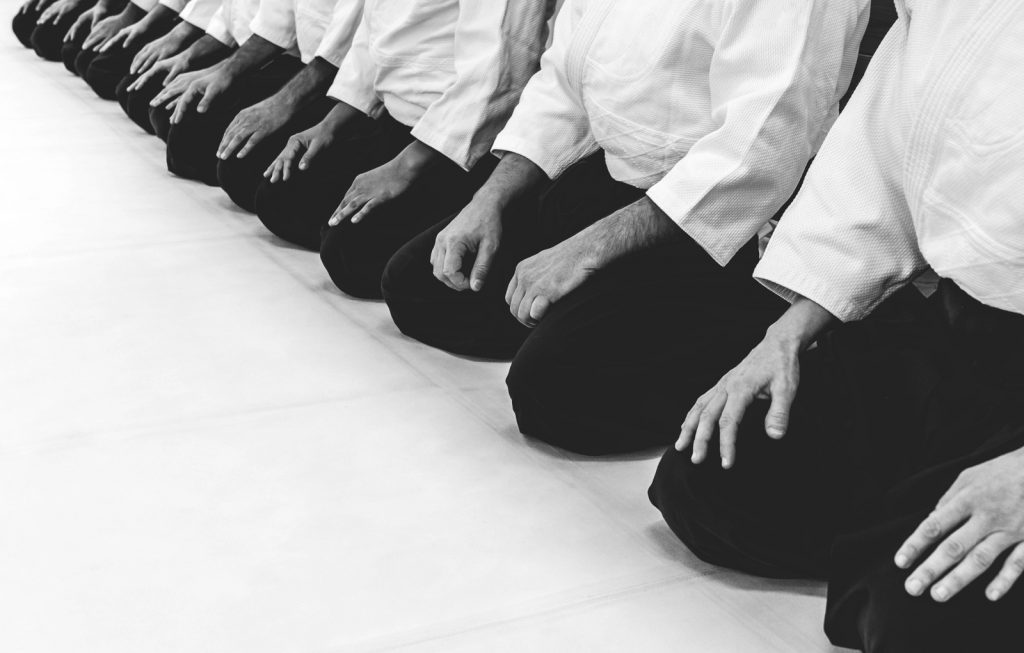Buddhist traditions agree that when Shakyamuni Buddha attained enlightenment, he was sitting in contemplation beneath the Bodhi tree. In that sense, we can say the Buddhist teachings sprang from meditation. The Buddha understood that body and mind are not separate but one, and meditating while sitting is an expression of nondualism.
In our Jodo Shinshu tradition, practicing meditation is frowned upon and considered a futile attempt at gaining spiritual awakening through “self-power.” Instead, we are urged to rely on the “other power” of Amida Buddha. This is most commonly done through nembutsu (reciting “Namu Amida Butsu”).
Despite being a Shin priest, for many years I have sat daily in meditation. It helps me to understand Jodo Shinshu and follow the nembutsu path. My practice is the kneeling form of sitting called seiza, Japanese for “quiet sitting.” This posture of meditation, which is easier than the full lotus position used by many meditators, is not limited to any one school or sect, nor is it attached to a particular form of meditation. It was popularized by Okada Torajiro (1872–1920), who made no boasts or claims about seiza beyond telling people to simply do it. Okada Sensei greatly respected Shinran Shonin, the founder of Jodo Shinshu. Okada Sensei said, “Seiza nurtures faith constantly after awakening (Jpn., gogo no choyo).”
Seiza sitting was not unknown in Jodo Shinshu before Okada Sensei took it up. Other practitioners also devotedly practiced seiza meditation, including the notable Higashi Honganji and Nishi Honganji teachers Daiei Kaneko and Yoshikiyo Hachiya.
Years ago, I asked my teacher, Reverend Norimasa Hachiya: “Sensei, Jodo Shinshu teaching focuses on nembutsu alone. Why do you practice seiza so diligently?” He replied: “For me, seiza cultivates the proper attitude to listen to the buddhadharma quietly without hakarai (a calculating mind). For Jodo Shinshu followers, this is most important.”
His father, Reverend Yoshikiyo Hachiya, often said: “Without doing seiza, I cannot realize the dharma.” At the Takakura lecture hall at Higashi Honganji headquarters in Kyoto, he would encourage audience members to sit seiza before his dharma talks. In that way, they would cultivate the proper attitude for understanding buddhadharma through both body and mind.
Diligent seiza practice helps focus the body and spirit on the hara, also called tanden (lower belly), considered in Japan and China to be the center of a person’s spiritual and physical energy. When “Namu Amida Butsu” spontaneously arises in my mind or comes out of my mouth, it naturally resonates from my hara. The hara is where one realizes “no hakarai” (mind of “no calculation”). As my teacher said, an uncalculating mind that is free of preconceived notions is better able to listen to and perceive truth.
Nembutsu is therefore an expression of an uncalculating mind that quells the ego and allows us to enter the vast ocean of Buddha wisdom. A daily practice of seiza helps nurture the nembutsu spirit to counter the turbulence of this world and the countless blind passions with which we run amok.
Morimoto Shonen Roshi, a Rinzai Buddhist master who was greatly admired by the scholar D. T. Suzuki, once said in a letter:
When we first consider Jodo-shu or Jodo Shinshu, they seem like schools of the “Easy Path.” Actually, it’s quite difficult to have faith (shinjin). Rennyo Shonin praised the devout follower Doshu for “consistently maintaining right faith” (shonen-sozoku). He was none other than a devoted practitioner of seiza. Seiza is the form and attitude of “consistently maintaining right faith.” Seiza itself is shonen-sozoku . . . because it is not one’s own practice, but rather, the meditation of Shakyamuni and other Buddhas in the ten directions, past, present, and future.
Rennyo Shonin (1415–1499) is considered the second founder of Jodo Shinshu. In The Sayings of Rennyo Shonin (Goichidaiki Kikigaki), he praised the devout follower Doshu as follows:
Although Doshu listened to the teachings constantly, he listened as if hearing them for the first time and he was grateful. Most people wish always to have something novel; but a person of faith feels everything is fresh and new, even if constantly repeated. Regardless of how many times they hear the teachings, they do so with open ears.
“If one entrusts oneself to Amida,” said Rennyo, “one’s entire body is wrapped in Namu Amida Butsu.” This means a true follower of the nembutsu way is filled with gratitude and joy.
Like Doshu, a person who truly has faith consistently maintains a mind of right faith. Many follow the “easy path” of Jodo Shinshu, but few become like Doshu. This type of realization is cultivated best by “sitting” rather than by reading books or listening to others.
I believe all Buddhist teachings spring from the sitting meditation (zazen) of the Buddhas. This is also true for Amida Buddha’s Great Vow (hongan), the essence of Jodo Shinshu. Zazen is a vital force that penetrates all and manifests itself in seiza.
Meditating beneath the Bodhi tree, Siddhartha Gautama attained enlightenment. Many years later, in a Tendai Buddhist monastery on Mount Hiei, Shinran Shonin practiced shikan meditation (“concentration” and “insight”; Skt., shamatha and vipashyana), which helped him nurture the power and energy of the hara. With this spiritual foundation, he was able to understand the words of his teacher Honen, “Just recite the nembutsu,” without a calculating mind. That’s why each and every day, I do seiza.
♦
Adapted from “Meditation and Jodo Shinshu” on higashihonganjiusa.org.
Thank you for subscribing to Tricycle! As a nonprofit, we depend on readers like you to keep Buddhist teachings and practices widely available.
